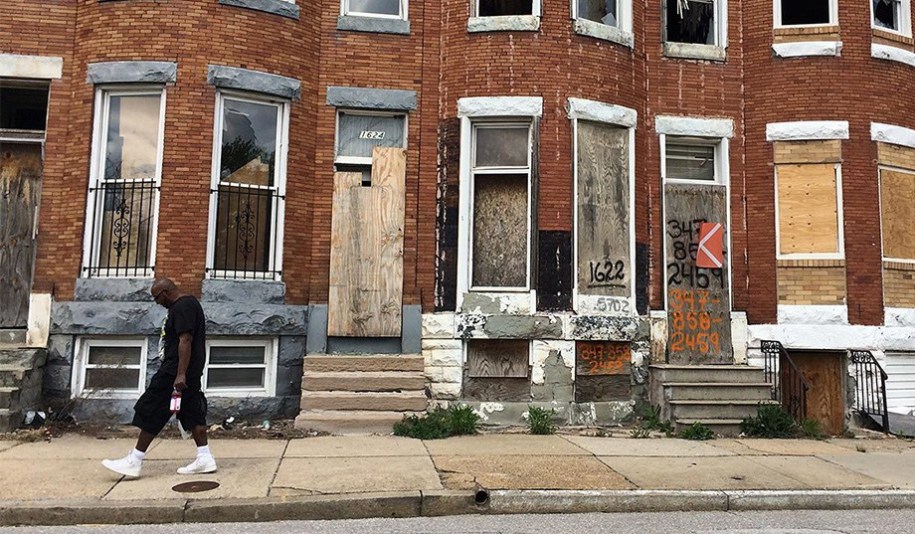
How Not to Combat Disinvestment
Originally published in City Journal
Wholesale property tax cuts are fairer and more effective than special tax breaks
One of Baltimore’s favorite daughters, novelist Laura Lippmann, has said that her city “suffers from nostalgia” that “keeps us from being honest in talking about what really happened here.” And when we do talk about our city’s tragic decline, we’re often in denial about what happened. Though Baltimore has embraced progressive policies for generations—creating a public-housing authority before many other cities, electing only Democrats for over a half-century, and hiking property taxes 19 times between 1950 and 1975—the city’s political and opinion leaders almost invariably point to “a history of inequity” when assigning responsibility for its failures. That omits other contributors to the city’s population loss, homicide rate, and failing schools, such as an unfavorable tax environment.
Baltimore’s latest idea to treat its resident-flight problem commits the same error. Presiding over a city with more than 16,000 vacant structures, city officials are proposing a nostalgia-inspired revival of the 1970s-era “dollar houses” program. Back then, the city sold abandoned properties for a buck to buyers who promised to fix them up and live in them a while. The fondly remembered program is often credited with starting a renaissance, but that’s an illusion: fewer than 200 houses were actually sold through the program, which did little to stem the city’s 13 percent population loss during that decade.
Addressing vacancies can help solve a city’s problems, but Baltimore would be better off tackling a major root cause of property abandonment: all those postwar tax hikes.
Baltimore has a unique political geography. It is completely surrounded by a separate jurisdiction—Baltimore County—with a property tax rate half the city’s. City residents are thus never more than a few miles away from a superior investment environment. For every $100,000 invested in city property, the annual principal, interest, and tax bill on a 30-year mortgage at 4 percent interest totals $8,084. That’s 17 percent more than on a similar investment in the county. Unless city properties deliver more amenities or receive improved services in exchange, investment dollars—and with them, people and jobs—will flow out of the city and toward the county.
The ill effects of this disinvestment and flight don’t show up overnight. As any homeowner or landlord knows, buildings decay slowly but inevitably. They require regular capital infusions (new roofs, upgraded kitchens) to maintain their value. Since the returns on such expenditures are lower in high-tax environments like Baltimore, they will be made with less frequency or not at all. Slow, steady decay will afflict such areas; lower-quality structures may eventually become uninhabitable and abandoned, reducing property values and hurting quality of life throughout a neighborhood.
Meantime, conscientious property owners who do invest fall victim to an adverse wealth effect. If you owned a $100,000 home in Baltimore County a decade ago, you might sell it for $200,000 today (per the Case-Shiller home price index). Anyone considering buying an identical house in the city, however, would be on the hook for those higher tax payments—which would be factored into its price. To match the monthly mortgage bill on the county property, the same city home could sell for only about $170,000. Effectively, the city homeowner has paid a $30,000 “wealth tax” over the last decade. That’s a problem for a city trying to retain existing residents and attract new ones—and, in a city that’s 62 percent black, a major obstacle to progress against the racial wealth gap.
Baltimore’s elected officials have known for decades that the city’s tax rate repels investment. Accordingly, they’ve doled out special tax breaks and subsidies to induce redevelopment. Virtually every major project in Baltimore in recent years has received such breaks. Resurrecting the dollar-house program, to which some cash grants from the federal-spending bonanza might be added for lucky qualifiers, is just the latest variation.
But census data clearly show that special breaks aren’t enough to hold back the disinvestment tide. And they’re wickedly unfair. Thanks to those subsidies, the effective tax rate on a multimillionaire’s luxury hotel may be a small fraction of that levied on an elderly widow’s modest rowhome.
If they want to unleash a broad-based, organic investment surge, cities suffering from disinvestment and flight simply must cut their property taxes to competitive levels. Being competitive in the pursuit of mobile capital is not an option but a necessity. And a well-planned, phased-in tax reform program need not do violence to short-term municipal budgets and services.
“A place doesn’t have to be perfect to be beloved,” says Lippman, the novelist, “and I love this city and I love it better for seeing its flaws.” Many Baltimoreans share that sentiment. But until we fix the policy flaw at the heart of the city’s economic struggles, there will be fewer of us to love it every year.
Stephen J. K. Walters is the author of Boom Towns: Restoring the Urban American Dream and chief economist at the Maryland Public Policy Institute.





